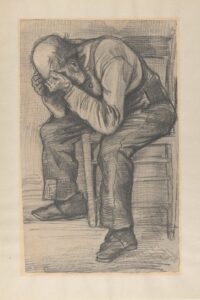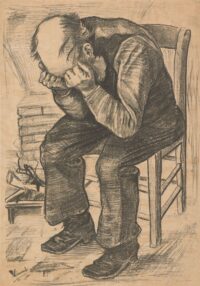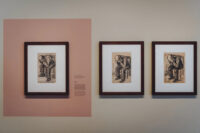
Teio Meedendorp (senior researcher Van Gogh Museum): “Stylistically, it fits effortlessly between the many figure studies we know of Van Gogh from his time in The Hague, and the link with Worn out is obvious. Van Gogh started by applying a grid on the paper, which indicates the use of a perspective frame. He did this to quickly outline a figure in correct proportions. The further elaboration was done in an expressive style characteristic of him: not refined, but with energetic scratches and strokes, the initiation of contours, in search of a concise representation with attention to light-dark effects.”
Meedendorp: “In terms of the use of materials, you also come across everything you would expect in a Van Gogh drawing from this period: thick carpenter’s pencil as a medium, coarse watercolor paper as a carrier, fixing it afterwards with a mixture of water and milk. The back of the drawing has damage on the corners, which can be related to the usual way in which Van Gogh attached a sheet of paper to his drawing board, namely with wads of starch.”

But the drawings of Zuyderland precede the first explicit mention of him in letters. He writes about Worn Out in a letter to his friend, artist Anthon von Rappard, on October 15th, 1881, and it’s clear from context Vincent has already shown one version of the work to Anthon, and is planning on showing him a larger one. It comes up again in a letter to van Rappard from November 24h, 1882.
You remember that drawing Worn out? In the last few days I’ve done it again no fewer than three times with two models, and will labour on it some more. For the present I have one that will be the subject of a fifth stone, which thus depicts an old working man who sits and ponders with his elbows on his knees and his head (a bald crown this time) in his hands.
He writes about it to Theo too, on the same day. The Van Gogh Museum experts believe both the preparatory study and the final drawing were made on the same day right around when those two letters were written, either on November 24th, or the day before.
The preliminary study is different from the final drawing and lithograph, in large part because Van Gogh was sitting close to the model when he did the study, and standing a little further back when he drew the final piece. The angle of the sitter changes, the legs are closer together, the elbows tighter to the body.
The study has been in the family of the current owners (whose identities are being kept under wraps at their request) since 1910, and they have never wanted it publically displayed. Privately, several scholars have examined it over the years and there has been debate as to its authenticity. The owners asked the Van Gogh Museum to examine it and if possible confirm its attribution. They determined it to be an authentic work by Vincent van Gogh. The owners chose not to make the attribution public, and kept the good news quiet until Thursday when the drawing’s authentication and its public exhibition were announced at the same time.

from The History Blog https://ift.tt/3kmCU7h








0 comments:
Post a Comment